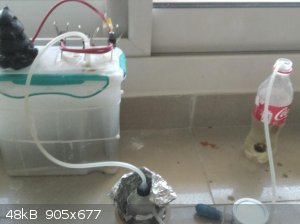mysteriusbhoice
Hazard to Others
  
Posts: 473
Registered: 27-1-2016
Member Is Offline
Mood: Became chemistry catboy Vtuber Nyaa
|
|
pH buffered Chlorate cell with CaCl2 additive no chromates
I did a run on my Chlorate cell amateur style but using CaCl2 to act as a buffer to keep the pH low around 7.2 giving a theoretical CE of 78%.
Video here
https://youtu.be/haJnkx2Gnqk
setup description
Current: 25A
Source Voltage: 5.01V
Cell voltage: 4.70V
Current density of anodes : 80ma/cm^2
temp: 53 Celsius (cooling)
temp: 60 Celsius (removed cooling day 3)
Operating temp range: 40-70 Celsius
Bulk fluid pH
pH: 4.9 (day1 bad calibration solution most likely around 7)
pH: 7.8 (day2, buffer ran out)
pH: 7.2 (day 3, 6 hrs later added conc CaCl2)
pH: 7.0 (day 3 night)
pH: 7.1 (day 4 ending day)
pH of buffered cell design:
7.2 with theoretical CE of 78%.
pH range: 7(start)----7(day1)---6.8-7.0(day4-5)end
pH near anode
pH: 6.8 (constant throughout the run
CE of this cell design: 70%-78%
Actual eff based on yield after cleanup:68% (includes seperation method)
electrodes: 2x MMO 1x Ti mesh electrodes
PSU: Meanwell sp-300-5 (discontinued) 5v 50A
recommend getting Meanwell LRS-320-5 5v 60A
vapours: horribly sour and a little sweet and also reeks of chlorine near the anodes.
Cell Liquor:cheap sea salt with horribly bitter taste due to high CaCl2 content and is hygroscopic.
buffer/additive: CaCl2 included in salt but about 5-10% by wt from total salt should do it.
IMPORTANT:
do not add calcium ions to your cell if your cathode is really close to your anode.
this can cause anode wear by the caustic cathode scales made of Ca(OH)2 and this is why industry does not add calcium ions to their operations.
Also its best to remove those anti caking agents because they can cause problems in the long run but my lazy ass forgot to do so.
[Edited on 8-6-2020 by mysteriusbhoice]
|
|
|
mysteriusbhoice
Hazard to Others
  
Posts: 473
Registered: 27-1-2016
Member Is Offline
Mood: Became chemistry catboy Vtuber Nyaa
|
|
for the seperation step to avoid complete loss of some product I precipitate the last bit of recovered cell liquir using KCl to make KClO3 which I can
then use when mixed with 60/40 NaClO3 to produce KClO4 when heated in a ceramic plate for 1 hour.
overall my take on perchlorates though is that its harder to make good pyro mixes with them because they are so stable that they will burn pretty
slowly harder to light or will not burn all at once if your ratios are wrong.
I dont really do pyro stuff much and made that for fun video comming soon on that btw.
|
|
|
mysteriusbhoice
Hazard to Others
  
Posts: 473
Registered: 27-1-2016
Member Is Offline
Mood: Became chemistry catboy Vtuber Nyaa
|
|
I found a use for the escaping Cl2 gas which btw is very pungent and noxious.
making really clean NaClO bleach by passing it through NaOH
I was thinking of making HCl by doing the whole flame + cooling thing but its a tad bit too dangerous for my taste.

btw changed my mind about letting it run to saturation I have a new recovery method that seperates NaCl from NaClO3 effectively using humidification.
[Edited on 9-6-2020 by mysteriusbhoice]
|
|
|